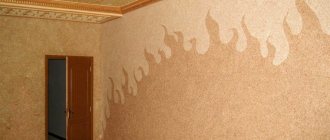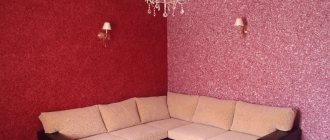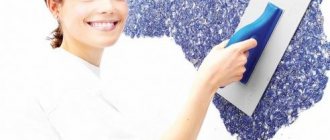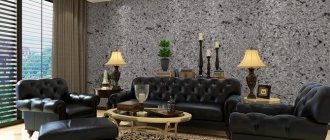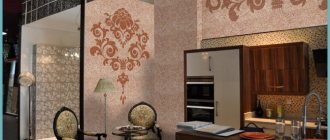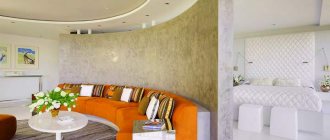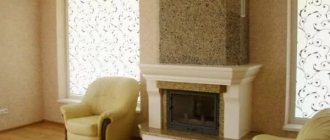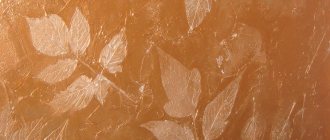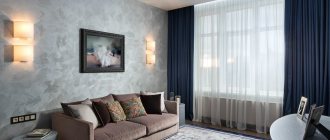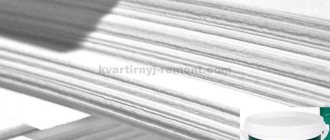What is the fundamental difference between these two options?
When the question arises: “which finish is better - wallpaper or decorative plaster,” we should not forget that liquid wallpaper itself is just a type of plaster. In other words, we are talking about comparing the particular with the general, and if liquid wallpaper has fairly standard characteristics, then plaster offers a slightly wider selection of qualities. More correctly, this question would be formulated as a choice between liquid wallpaper and other types of decorative plaster.
For what qualities is liquid wallpaper chosen?
Liquid wallpaper has a number of advantages - enough to give preference to them. Judge for yourself:
- The relatively low cost allows literally anyone to purchase liquid wallpaper - they are much cheaper than competing decorative plaster, even in their elite version.
- In case of any damage to the coating, there is no need to grab your head, because the problem can be solved extremely simply. It is enough to thoroughly wet the material near the damaged area - it will turn into a substance as soft as plasticine, then carefully seal the defect with your fingers. If the damage is significant, you can completely replace the damaged fragment - to do this, part of the mixture prepared during finishing must be kept frozen.
Damaged liquid wallpaper finish can be easily repaired
- If the owner of the premises decides that it is time for a new finish, he will not have any problems with removing liquid wallpaper.
- Applying liquid wallpaper does not require any special skills or long training - you only need patience and accuracy. However, any sloppiness in this case can be corrected quite easily.
Thus, liquid wallpaper is definitely better in terms of the financial side of the issue - if decorative plaster still turns out to be cheaper, then the quality of such finishing will be quite low. Wallpaper is also more relevant in a situation where there are four-legged pets in the house, since they are extremely easy to repair, and are also the best solution if the repairs for some reason are not done for long.
Another thing is that liquid wallpaper is completely inapplicable in the kitchen or bathroom, as well as in walk-through rooms, and they do not differ in the special variety of design solutions available for choice.
Pros and cons of decorative plaster
Of course, decorative plaster also has certain characteristics that make people prefer it. The most commonly noted benefits are:
- This material provides enormous space for real creativity, offering the widest range of available colors and shades, the ability to combine them, create three-dimensional shapes, and so on.
- Decorative plaster is not afraid of water, so it can be washed without fear of repairs. If you still have concerns about ruining the finish with an incorrectly calculated amount of water, you can coat the finished surface with special protective compounds.
- Plaster is generally stronger than liquid wallpaper; mechanical damage is not so dangerous for it.
- Such repairs are definitely more durable; they are able to maintain their original appearance for decades without fading or fading.
Unlike liquid wallpaper, decorative plaster is stronger and more durable
So, if the renovation customer considers himself one of those people who love stability and durability in everything, including interior decoration, then it is better to choose decorative plaster, because upon completion of the work there will be no problems with it. This option will fit perfectly into any room in an apartment, house, or office. The material is designed to create the maximum aesthetic effect, allowing the owner to express himself (provided that he himself participated in the development of the repair) or simply be proud of the result.
General advantages and disadvantages
If you turn to encyclopedic reference books, you can find the following characteristic of decorative plaster - this is the finishing layer of a hardened solution of alabaster, lime or gypsum, applied to the walls and ceiling to give the surface an aesthetic appearance.
Liquid wallpaper is, in principle, the same decorative plaster, i.e. a hardened layer of mixture applied to walls for finishing. The following facts indicate a confusion of concepts: in the technical specifications liquid wallpaper is designated by the term “silk plaster,” and Wikipedia classifies silk plaster as one of the types of decorative. There is another term that causes confusion - “Danish decorative plaster”, which is actually liquid wallpaper.
In order not to get confused, you need to understand the difference between these finishing materials. Their main and only difference is that decorative plaster contains quartz sand, while liquid wallpaper does not contain it - it is replaced by cellulose.
Another surprising thing is that these materials have almost identical advantages. If we talk about the advantages, they are:
- applied to walls made of any material: gypsum plasterboard, brick, stone, concrete, wood;
- hide imperfections in the surface of a wall or ceiling: cracks, cracks, sinkholes, chips;
- allow you to create various patterns and full-fledged drawings, in color;
- have good sound insulation properties;
- regulate the microclimate in the room thanks to the ability to “breathe”;
- good insulation;
- have a long service life;
- belong to an environmentally friendly finishing material - the components of the mixture are not hypoallergenic;
- have no seams or joints - a solid surface is more aesthetically pleasing and durable;
- do not have waste in the form of paper scraps, adhesive residues, etc.
At the same time, there is still a difference between decorative plaster and liquid wallpaper.
Decorative plaster
This plaster has additional advantages:
- high surface strength - difficult to damage mechanically;
- easy care - the wall is cleaned with a wet cloth or vacuum cleaner;
- is not afraid of water, so you can plaster rooms with high humidity (bathroom, kitchen);
- also used for outdoor work - withstands temperature changes from -55 to +60 degrees Celsius;
- has enormous potential for implementing various design ideas;
- Retains rich, bright color throughout its service life.
The disadvantages include:
- high cost of finishing;
- difficulty in restoring damaged areas (in most cases restoration is impossible);
- cannot be applied to walls in houses that shrink - they will crack;
- the labor-intensive process of removing from the walls during replacement;
- professionals are required to carry out the work - a complex and labor-intensive plastering technology.
Liquid wallpaper
Among the advantages inherent only in liquid wallpaper, the following stand out:
- elasticity - withstands any shrinkage and does not crack;
- do not require experience or training - any beginner can do the job;
- budget cost of finishing;
- ease of removal when switching to another type of finish;
- can be restored if damaged during operation;
- pleasant appearance and texture - soft to the touch, reminiscent of silk.
For information: for repairs, you can use frozen mixtures left over after finishing the finishing work.
Minuses:
- are afraid of moisture - can only be used in living rooms and hallways;
- cannot be used for façade finishing;
- limited color and texture;
- They fade quickly when exposed to ultraviolet rays.
Which is better: decorative plaster or liquid wallpaper?
It is quite difficult to decide which decor is better than one or the other, because any of the decorative finishing materials has a number of pros and cons. In fact, this topic is quite difficult, because when choosing this or that material, you need to understand that there is no ideal material for wall decoration, since each one is tailored for certain moments. These pros and cons mean that each potential owner of an apartment or house has his own renovation tasks. The type of room, temperature, conditions, and even the presence of small children or pets are also relevant to the choice. All these nuances are important.
Today we will try to compare two completely different materials for wall decoration: decorative plaster and liquid wallpaper and tell you about the pros and cons of these materials. Don't expect us to give a definitive verdict that one material is better than another. It is worth understanding that even among one type of material it is possible to make comparisons for a long time, because decorative plaster can be different and of different prices, and also liquid wallpaper can be completely different and of different composition.
Speaking about decorative plaster, we can say that it can be completely different depending on the desired effect, as well as the manufacturer.
If we talk about liquid wallpaper, then each manufacturer uses different components to produce the product.
The choice is yours, and we will just talk a little about these products.
What to choose
Previously, wall finishing options were limited to wallpapering the walls. It could be:
- smooth paper materials;
- vinyl combinations;
- Flyserin;
- with a convex texture;
- or special material for painting.
Today priority belongs to decorative mixtures, which are gradually replacing traditional paper materials. Today you can easily purchase various materials, but that’s not the point. It is important to determine the benefits of the product, processing methods and application nuances. The gallery of works will help you decide which is better, wallpaper or decorative plaster.
Advantages of decorative plaster
If you decide to use decorative plaster instead of wallpaper, you need to know about its positive properties.
The advantages of the material in question can be considered:
- Possibility of plastering the facade of the house and interior spaces.
- A huge variety of decorative effects gives room for imagination. You can become the creator of your room by choosing an option that suits you personally.
- In the future, decorative plaster can be coated with paint. This process can be repeated many times.
- The service life of plaster is higher than that of competing materials and can reach 60 years.
- Decorative plaster is suitable for almost any style of wall cladding.
- Decorative mixtures are characterized by high adhesion and vapor/permeability. This allows you to work in rooms with high humidity and use the material in the kitchen and bathroom.
This is not a complete list of the positive qualities of the selected material.
Of course, there are also negative aspects that should be discussed directly: the high cost of work and a labor-intensive process.
Venetian plaster
The use of Venetian plaster in the interior is considered a special chic. It's not just about the high cost of work and painstaking labor. Decorating the walls with marble gives the room a certain degree of pomp. A room furnished with this finishing material plays with completely different, deeper colors. Despite the high cost of work from 1 thousand rubles to 1500 rubles/m2, many people prefer this not cheap option.
Liquid wallpaper
- Liquid wallpaper is a fairly new material that not everyone knows yet. Often, liquid wallpaper is rather the younger brother of rolled wallpaper and decorative plaster at the same time. If you cannot choose between roll wallpaper and decorative plaster, then simply choose liquid wallpaper.
- Firstly, liquid wallpaper is sold either in the form of a solution ready to be applied with a spatula, or in the form of powder bags that need to be diluted with water and stirred.
- Liquid wallpaper has the advantage of being warm, unlike decorative plaster. No matter what kind of plaster you apply and what effect you imitate, it will be a continuation of stone walls and, in addition, solid walls.
- Liquid wallpaper is warm and soft, so it gives a special coziness. If this is not so important for hot countries, then for our hemisphere, where rain and wind dominate to a greater extent, this is an important point.
- We would recommend using liquid wallpaper in bedrooms, because this is where comfort and coziness are so important.
- It is worth saying a little about prices. Liquid wallpaper is never cheap, so there is definitely a minus here, but if you compare it with decorative plaster, you cannot say that it (plaster) will be cheaper, rather the opposite.
Decorative plaster
- This material is one of those materials that can be said to be expensive and elite. However, decorative plaster is a rather cold material and not everyone wants to have stone walls as decor in their bedroom or children’s room.
- Decorative plaster can imitate different effects, be it concrete or silk, so you have a wide choice of style for your interior, but you should also understand that to properly apply decorative plaster you need to have good experience and knowledge, or hire professional finishers.
- If you compare prices, decorative plaster will most likely always be more expensive.
- If in the future you come to dismantle decorative plaster, then most likely you will have to face painstaking and dirty work, when dismantling liquid wallpaper will be much easier.
- Decorative plaster is wear-resistant and can be washed, so it will fit perfectly into the interior of corridors, living rooms and kitchens.
Conclusions on the topic
Thus, we told you that decorative plaster or liquid wallpaper is better. Of course, we have not come to a clear answer. Each of you will answer this question in your own way, having familiarized yourself with the disadvantages and advantages of this or that finishing material. Depending on the type of room, your budget, goals and objectives, you will choose your material.
You can also read about other finishing materials on our website, just use the search and find the information that will be of interest to you.
If you have any questions, you are welcome to comment on the article, where we and our users will be happy to help everyone!
Source: delaisteny.ru
Which is cheaper?
To understand what is cheaper, you need to start not from the price of a unit of material, but from the cost of 1 m2 of wall covered with each type of finish - then you can take into account the consumption of material per unit area and the cost of finishing work.
Liquid wallpaper. The cost of 1 kg starts at 150 rubles. But this is a cellulose-based material. Combined and cotton ones cost 250-550 rubles. For calculations, let’s take the average value - 400 rubles / kg. The mixture consumption per unit area is in practice higher than what manufacturers indicate and is 4 m2 versus 5 m2. Therefore, you need to spend 100 rubles to purchase materials per square meter of wall.
The cost of work starts from 250 rubles/m2. In fact, you can order a master for 300 rubles. Total 1 m2 of wall costs 400 rubles.
For reference: 1 m2 of silk wallpaper will cost 1150-1300 rubles. for 1 m2. But, let us emphasize, this is the most expensive type of liquid wallpaper.
Decorative plaster. The price (25 kg bag) has a huge range - from 500 rubles. up to 4000 rub. The average price range is 1000-2000 rubles. per package. Consumption, depending on the type of plaster, ranges from 1.5 kg/m2 to 4 kg/m2. Let's focus on the average value of 2.5 kg/m2. Then the cost of decorative plaster per 1 m2 of wall will be 150 rubles/m2 (1500 rubles/25 kg/2.5 kg/m2).
You can order a master for 300-1200 rubles/m2. At the same time, the price of 300-350 rubles/m2 applies exclusively to phlox plaster. For other types it starts at a price of 450 rubles/m2. As a result, applying decorative plaster will cost at least 600 rubles/m2, on average 850-950 rubles/m2. The most expensive plaster costs approximately 5.0-6.0 thousand rubles. for 1 m2.
Conclusion: if you start from the cost factor, the problem: decorative plaster or liquid wallpaper - what to choose is easy to solve. Liquid wallpaper is much cheaper, especially since cotton and silk types are difficult to distinguish from textured and structural plaster.
Choosing fashionable clothes for the walls: liquid wallpaper or decorative plaster?
Today we have much more opportunities to create an interesting interior than 10-20 years ago. New materials make it possible to make walls textured and voluminous, realizing the most incredible fantasies of the owners. Liquid finishing coatings are best suited for this difficult task. Liquid wallpaper and decorative plaster have recently gained enormous popularity, but many people confuse them. Yes, the materials are similar in some ways, but they are very different in composition and method of application. Let's look at the features of coatings. This will help you accurately choose the basis for your interior.
What is liquid wallpaper?
This material combines the advantages of plaster and ordinary wallpaper. It includes:
• threads of silk, cotton, cellulose or a combination of silk and cellulose;
• additional components (mother of pearl, sparkles, etc.).
Liquid wallpaper is sold in three types:
• dry powder - you just need to dilute it with water according to the instructions and apply it to the walls;
• liquid mixture - this material is completely ready for use;
• dry powder, which requires special skills to create the finished mixture and apply - glitter or other components must be added to the white substance to obtain effects, and only a professional can apply it.
The first option is most often found in stores. It is important to strictly follow the instructions when diluting and use the entire package so as not to upset the proportions.
Liquid wallpapers are:
The strongest ones are the first ones. The latter are quite difficult to find on sale, but they attract with their special warmth and texture pleasant to the touch. Some connoisseurs are sure to find them. Cellulose wallpaper is the cheapest, and silk-cellulose wallpaper can be purchased at an average price.
What is decorative plaster?
This is a top coat that is water based. It is supplemented by all kinds of thickeners, slaked lime, gypsum, mineral binders, water-repellent substances and other additives.
Decorative plaster allows you to create a special texture and imitate the original relief and pattern. Its capabilities are much wider than those of liquid wallpaper. Using the material it is easy to create aristocratic, cosmic and other original interiors.
Types of decorative plaster
• Venetian - imitates natural stone, which is partially or completely polished (from marble to malachite), sometimes reminiscent of fabric or embossed leather. Has a smooth and shiny finish. A unique effect is achieved through the use of special application techniques.
• Textured - capable of creating volume. The base is synthetic materials with fillers (linen, cotton fibers, crumbs of natural or artificial materials - small stones, mica, and so on).
• Smooth - allows you to create a plain wall covering, interesting paintings or unusual effects in the form of a mother-of-pearl shell, sea foam or something else.
• Structural - a homogeneous mixture with fine-grained filler, capable of creating non-volumetric visual imitations (for example, wild stone, tree bark).
• Flock - the newest type of plaster, characterized by the presence of small fragments of a different color. They are called flocks. It is applied in three stages: adhesive base, flocking, varnish.
Comparison of technical and operational characteristics
The above advantages and disadvantages do not answer the question: what is better - liquid wallpaper or decorative plaster? To continue the comparison, let’s look at the technical, technological and operational characteristics of these types of finishes.
Decorative plaster
Does not have a specific composition. It has different binders, fillers and thickeners. The only component included in all possible plaster solutions is quartz sand, used as additives.
The most popular types of decorative plaster are:
- Mineral. The binder is cement. Moisture resistant. Has a low price;
- Polymer. Acrylic based. Very plastic and durable, resistant to aggressive environments;
- Silicone. The main component is silicone resin. The advantages include the ability not to retain dust on its surface;
- Silicate plaster is produced on the basis of liquid glass. Resistant to mold and mildew, retards open flames during a fire.
The type of filler determines the aesthetic characteristics of the plaster.
Mica particles, wood fibers and small stones give textured decorative plaster, which in turn can have varieties:
- “Lamb” - the surface is smooth, grainy. From the outside it resembles soft wool;
- “Fur coat” - a plastered wall is similar to the previous finishing option, but not soft, but fleecy;
- “Bark beetle” is a very popular type, in which the walls resemble old wood, undermined by the bark beetle - passages are visible.
Already from the name it is clear that textured plaster has a pronounced texture, which allows you to hide all the imperfections of the wall under the plaster layer. At the same time, the application technology is the simplest: you can do the work yourself.
Structural plaster is based on the finest quartz sand and mica. To obtain an unusual surface texture, wood fibers or silk in the form of threads are sometimes added. After applying such a solution, the wall has a homogeneous structure, onto which an imitation of tree bark, sandstone, etc. can be applied with special rollers.
Venetian plaster perfectly imitates real marble. This is facilitated by special mineral fillers: marble, granite and quartz chips. At the same time, with a decrease in the size of the filler fractions, the pattern becomes more delicate and deeper.
The plaster is sold ready to use. Has a translucent appearance. It is tinted to match the color of the marble that will be used to decorate the room. Its peculiarity is that with each layer of plaster the finish becomes more luxurious, playing with different shades. To enhance the effect of natural stone, the surface of the wall is coated with wax and sanded.
A new product on the construction market is flock decorative plaster . It is based on several layers applied in a certain sequence to the wall: glue, then multi-colored flocks (also called chips) made of acrylic paint, and on top varnish (this type of plaster does not fit into the classical definitions - it does not contain quartz sand).
Liquid wallpaper
Depending on the filler, they are:
- cotton;
- silk;
- cellulose;
- combined (silk-cellulose).
Cotton wallpaper. They are very similar to decorative plaster - even experts do not always immediately determine the type of finishing material. They consist of cotton and cellulose fiber, decorative fillers and mineral additives.
They have a non-standard texture, which allows, as in the case of plaster, to create various panels and stucco molding. If necessary, enhance the color palette - add additional paint. The disadvantage of such wallpaper is its rather high price.
Cotton liquid wallpaper.
Silk wallpaper. The most expensive type (without labor costs). Contains silk and cotton fibers, mineral fillers, dyes and glue.
Please note: the components of cotton and silk wallpaper are similar. The difference is the amount of each type of fiber in each type of liquid plaster.
The smooth texture can be varied: by embossing with a special roller, a figured spatula, cutting the relief with a stick or various sparkles (glitter). Thanks to this texture property, wallpaper is universal - it can be used in any room with any interior. If necessary, you can additionally paint. They do not fade much under direct UV rays, and therefore have a long service life without additional repainting.
Cellulose wallpaper. It is based on wood fibers, which is why it is the cheapest type of liquid wallpaper. Accordingly, they have lower performance indicators: they are unpresentable in appearance, and short-lived in terms of service life.
Silk-cellulose wallpaper. A more profitable option for wall decoration - adding silk removes all the disadvantages of cellulose wallpaper, except for the main thing - the service life increases, but only slightly.
Comparing the various characteristics of these types of finishes still does not make it clear where to stop, and even more confusing. Therefore, let's compare the cost factor.
What is the difference between decorative plaster and liquid wallpaper, which is better to choose?
When starting renovations, owners must decide for themselves on the choice of finishing materials for the walls in the premises. For example, how do you like these finishing options: liquid wallpaper or decorative plaster , how to decide on the choice and what is preferable to use? Both types of decorative materials have undeniable advantages over conventional methods of repair work. For the inexperienced consumer, both decorative plaster and liquid wallpaper are almost identical in their parameters, but they still have distinctive features. We will try to briefly outline the main differences.
Types of liquid wallpaper
Liquid wallpaper is classified according to the filler material. The appearance and strength characteristics depend on this.
The list of types is not as long as that of decorative plasters:
- cellulose;
- cotton;
- silk;
- combined.
Survey. What type of liquid wallpaper do you prefer?
Cellulose 30.61%
Cotton 12.24%
Silk 32.65%
Combined 24.49%
Voted: 49
In addition to differences in material, liquid wallpaper differs in its application. Basically, they are ready-made finishing material. But they can also be a substrate that creates the texture of the surface being finished.
Based on the surface texture they are distinguished:
- smooth;
- embossed liquid wallpaper.
Cotton
The raw materials for the filler are 100% natural cotton fibers. Its share in the mass is 98%, the rest consists of additives of cellulose and textile fibers, mica, which adds shine. The drying time for coatings with a thickness of 1-10 mm is 48 hours. The mass with cotton fibers creates a rough coating and a velvety matte sheen.
cotton
Manufacturers have taken care of the richness of the color palette and offer about 240 shades. Among them you can always find what you want, but if a more exact color match is needed, you can mix mixtures of the desired tones, as artists do. You can also use colors.
Cotton blends are most often used to decorate bedrooms, as well as rooms for young family members, and office interiors. The choice is based on increased safety and non-toxicity. In addition, children's rooms and offices like to be transformed more often, so the fact that the cotton composition is not as durable as silk does not play a special role.
Silk
The inclusion of silk fibers gives the coating a silky shine. The coatings have the effect of expensive fabric shimmering in the light. In addition to natural silk fibers, the mixture contains artificial silk fibers, decorative additives and colored quartz.
silk
Such compositions look richer, and their price is higher, although the latter is relative. They are more durable than silk plaster of other categories. The use of such finishing material is universal. It is most suitable for luxury apartments, commercial properties and administrative premises. In terms of sophistication it can be as good as Venetian plaster. Pairs perfectly with cork, natural stone, and snow-white stucco.
Silk coating will last up to 10 years without losing its originality and freshness of colors. It absorbs almost no odors. The coating firmly “clings” to the base without swelling or delamination. When protected with acrylic varnish, it can be used in damp rooms.
Pulp
The filler material is wood waste. Another name is paper. This is the cheapest material. Most often used for cold, non-residential premises.
celluloseCellulose mixtures lend themselves well to additional coloring and are easily restored. Least durable. The cost is almost the same as that of cotton ones.
Combined
Blends with silk and cellulose fibers or silk-cotton compositions have their own charm.
combined
Ugly and embossed liquid wallpaper
Almost all of the wallpapers listed above can be made with different surface textures.
Embossed wallpaper will help hide minor imperfections in the base and, accordingly, are less demanding in its preparation. Such wallpaper will help you bring to life the most daring design solutions. With all this, the terrain (as always) will accumulate more dust.
Smooth wallpaper, in turn, is more familiar to the average person, and is also more often distinguished by a variety of design options.
Paintable liquid wallpaper
On the shelves we can find the so-called “base”. This is an unpainted dry mass, which is also called unfinished wallpaper. You can add not only dye to this mixture, but also glitter and other decorative additives (optional).
Liquid wallpaper or decorative plaster, what are the differences?
In terms of their manufacturability (methods of application), decorative plasters differ from liquid wallpaper in a wide variety . With the help of decorative plasters you can create unique surfaces:
- various textures (imitation brickwork, decorative stones, leather and much more);
- The color palette can be very extensive and original at the request of the customer.
Liquid wallpaper in this regard is much “poorer” than decorative plasters. It is much more difficult to create an interesting texture with liquid wallpaper, but in terms of colors, liquid wallpaper can give the consumer a wide choice .
Even people inexperienced in repairs can cover various surfaces with liquid wallpaper, but decorative plasters will require professional skills and it is advisable to involve professionals in such work.
The areas of use of liquid wallpaper and decorative plaster differ. Liquid wallpaper cannot be used when decorating external walls, while decorative plaster is successfully used both for interior spaces and outdoor surfaces.
Types of plaster
Decorative plaster can be:
- Stone. It perfectly imitates natural material. Small pebbles of different sizes can be used as filler. During the installation process, it is recommended to use different methods of applying the material to create a more natural look for the base.
- Venetian. In this case, the composition contains marble chips and flour. As a result, it is possible to obtain a coating that is practically indistinguishable from real marble with a characteristic translucent structure. However, you need to be prepared for the fact that during the work you will need to polish each layer. It is also worth noting the fragility of the finished coating. It can be damaged by one hit.
- Sgraffito. In this case, textured patterns or panels are created on the surface. However, to create such a unique coating you need to have the appropriate skills and be prepared for lengthy work. As a rule, such solutions are more often used for restaurants, hotels, and cafes.
- Color. In this case, colors, dyes and various decorative additives are used.
- Terrazitova. Such mixtures contain sand, quartz and marble particles. The basis of the composition is exclusively mineral. Laying is done in layers. This solution is most often used for facade finishing.
- Silk. In this case, natural or synthetic fibers can also be used. Also, as in the case of wallpaper, the composition may include glitter, which will give an additional silver or golden tint.
Decorative plaster can be silicate, acrylic, silicone and mineral. The compositions can be used for both interior and facade decoration of buildings.
Pros and cons of plaster
Among the main advantages are:
- The ability to create unique shapes and wall designs.
- Easy to care for.
- Increased strength (with the exception of a few varieties) to mechanical damage.
- Durability.
Among the disadvantages, installation can be distinguished. If any section of such plaster is damaged, it will be very difficult to restore it yourself. Problems will also arise during the process of dismantling the coating.
It is also worth paying attention to the high price of such mixtures. A 25-kilogram bag of the mixture will cost 550-3600 rubles. Accordingly, finishing 1 m2 will cost 140-2400 rubles. This scatter is due to the many types of compositions.
Application method
Most often, you need to hire a finisher for the job. The main stages of applying plaster are as follows:
- The old coating is removed from the wall and a primer is applied.
- A mixture is prepared (some formulations are sold ready-made, while others require dilution with water).
- The composition is applied to the wall using the method required for the specific coating.
- Using various tools, the necessary relief is created. This is usually done when the composition has already “set” a little.
- 20 minutes after this, when the surface ceases to shine with moisture, the relief is smoothed out.
- Small defects and irregularities are smoothed out.
- The composition dries out.
After this, additional processing is carried out, for example, gilding or painting, if required.
Differences between liquid wallpaper and decorative plaster in terms of maintainability
- the damaged area of liquid wallpaper is moistened with water, cleaned off with a spatula and a new portion of liquid wallpaper is applied;
- Decorative plaster has great strength, and repairing damaged areas seems to be a rather labor-intensive process with several technological operations.
Decorative plaster carries an element of prestige for the owner and emphasizes his status in society; liquid wallpaper is more democratic in this regard. Repair using liquid wallpaper takes less time than coating with decorative plasters.
The price factor is also important; liquid wallpaper will end up being cheaper than decorative plaster (in addition to plaster, additional materials, paints, primers, etc. are required).
Finishing with liquid wallpaper can be done more often than with decorative plaster. Finishing with decorative plasters provides a long service life.
What is the difference between decorative plaster and liquid wallpaper?
Let's sum it up:
- liquid wallpaper is cheaper than decorative plasters;
- applying decorative plaster takes a lot of time (preparatory processes, several stages of coating, painting, protective compounds, varnishes, wax, etc.);
- liquid wallpaper is “technological” even for beginners, easy to apply and prepare the mixture;
- liquid wallpaper is easily removed from surfaces and repaired, decorative plaster has a “death grip” and removal (repair) is labor-intensive and problematic;
- the thermal insulation properties of liquid wallpaper exceed those of decorative plasters;
- susceptibility to moisture narrows the scope of use of liquid wallpaper; decorative plasters cope well with the negative consequences of high humidity.
The final choice between materials is up to the consumer. We hope that our article will help him make the best decision.
Source: vidoboev.ru
Advantages and disadvantages of liquid wallpaper
Positive traits:
- Before applying the material, no thorough preparation of the base is required; the structure of the solution allows you to mask surface defects;
- the material is safe from an environmental point of view;
- installation does not require special skills;
- affordable price;
- vapor permeability allows the finished walls to “breathe”.
Negative qualities:
- this coating fades when exposed to direct sunlight;
- the structure of the material is destroyed at high humidity;
- the surface weakly resists mechanical stress.

